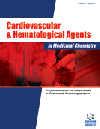- Home
- A-Z Publications
- Cardiovascular & Hematological Agents in Medicinal Chemistry (Formerly Current Medicinal Chemistry - Cardiovascular & Hematological Agents)
- Previous Issues
- Volume 10, Issue 2, 2012
Cardiovascular & Hematological Agents in Medicinal Chemistry (Formerly Current Medicinal Chemistry - Cardiovascular & Hematological Agents) - Volume 10, Issue 2, 2012
Volume 10, Issue 2, 2012
-
-
Adult Stem Cells and the Clinical Arena: Are we Able to Widely Use this Therapy in Patients with Chronic Limbs Arteriopathy and Ischemic Ulcers without Possibility of Revascularization?
More LessThe following paper is an overview on stem cells therapy in patients with peripheral vascular diseases. Recent research shows the ability of stem cells to develop and strengthen the collateral network in ischemic legs. Here, we discuss this clinical and therapeutic approach. To date, research has been mainly focused on patients with ischemic ulcers without possibility of revascularization. Non-invasive stem cell therapy has bee Read More
-
-
-
Treating Depression in Coronary Artery Disease and Chronic Heart Failure: What's new in using Selective Serotonin Re-Uptake Inhibitors?
More LessDepression is a common co-morbidity in patients with cardiovascular diseases such as chronic coronary artery disease, acute coronary syndromes, post by-pass surgery and chronic heart failure. The presence of depression is independently associated with a decline in health status and an increase in the risk of hospitalization and death for patients with coronary artery disease or congestive heart failure. Novel treatment m Read More
-
-
-
Dabigatran - A New Chapter in Anticoagulation
More LessAuthors: Shameer Ahmed, Vadim Levin, Robert Malacoff and Matthew W. MartinezFor the last 60 years warfarin has been the cornerstone for chronic anticoagulation in prevention of ischemic strokes and systemic embolization. Warfarin therapy has several limitations including frequent monitoring and various food and significant drug interactions, which make it a less than ideal chronic oral anticoagulant. The continued search for safe, effective, medications with predictable pharmacokinetic profiles has led Read More
-
-
-
PPAR- γ Agonist in Treatment of Diabetes: Cardiovascular Safety Considerations
More LessAuthors: Aamer Abbas, Jimena Blandon, Jennifer Rude, Ahmed Elfar and Debabrata MukherjeeThe peroxisome proliferator-activated receptors (PPARs) are nuclear fatty acid receptors, which contain a type II zinc finger DNA binding motif and a hydrophobic ligand binding pocket. These receptors are thought to play an important role in metabolic diseases such as obesity, insulin resistance, and coronary artery disease. Three subtypes of PPAR receptors have been described: PPARα, PPARδ/β, and PPARγ. PPARα is Read More
-
-
-
Pain Management in Hematological Patients with Major Organ Dysfunctions and Comorbid Illnesses
More LessBackground: Organ dysfunctions and medical complications, such as renal failure, liver impairment, coagulation disorders, cardiovascular and respiratory illnesses, may hamper an adequate pain management in haematological patients. Aim: To summarize current knowledge on pain management in hematological patients presenting major organ dysfunctions and comorbidity. We also attempted to provide recommen Read More
-
-
-
Does A Subclinical Cardiotoxic Effect of Clozapine Exist? Results from a Follow-up Pilot Study
More LessAuthors: Carlo Rostagno, Sandro Domenichetti and Gian Franco GensiniAim: The aim of the present study was to investigate by serial echocardiography and dosage of NT-pro-BNP, whether, in previously healthy subjects, long term therapy with clozapine may lead to subclinical cardiac toxicity. Methods and Results: 38 patients (24 males, 14 females, mean age 38.4 years) suffering from a severe personality disorder were enrolled. At inclusion duration of clozapine treatment averaged 66 months at a Read More
-
-
-
PF-04886847 (an Inhibitor of Plasma Kallikrein) Attenuates Inflammatory Mediators and Activation of Blood Coagulation in Rat Model of Lipopolysaccharide (LPS) - Induced Sepsis
More LessAuthors: D. Kolte, J. W. Bryant, G. W. Gibson, J. Wang and Z. Shariat-MadarThe plasma kallikrein-mediated proteolysis regulates both thrombosis and inflammation. Previous study has shown that PF-04886847 is a potent and competitive inhibitor of kallikrein, suggesting that it might be useful for the treatment of kallikrein-kinin mediated inflammatory and thrombotic disorders. In the rat model of lipopolysaccharide (LPS) -induced sepsis used in this study, pretreatment of rats with PF-04886847 (1 mg/k Read More
-
-
-
Microvascular Diseases: Is A New Era Coming?
More LessAuthors: N. Wiernsperger and J. R. RapinThe microvascular bed is an anatomical entity which comprises myriads of small arterioles, capillaries and venules. Microvessels and surrounding tissue metabolism are tightly coupled; consequently they are equipped with many, very specific and fine-tuned mechanisms allowing permanent, precise regulation of nutrient delivery. The review thoroughly describes the structure and physiology of arterioles and capillaries as well Read More
-
Volumes & issues
-
Volume 23 (2025)
-
Volume 22 (2024)
-
Volume 21 (2023)
-
Volume 20 (2022)
-
Volume 19 (2021)
-
Volume 18 (2020)
-
Volume 2 (2020)
-
Volume 17 (2019)
-
Volume 16 (2018)
-
Volume 15 (2017)
-
Volume 14 (2016)
-
Volume 13 (2015)
-
Volume 12 (2014)
-
Volume 11 (2013)
-
Volume 10 (2012)
-
Volume 9 (2011)
-
Volume 8 (2010)
-
Volume 7 (2009)
-
Volume 6 (2008)
-
Volume 5 (2007)
-
Volume 4 (2006)
Most Read This Month
Article
content/journals/chamc
Journal
10
5
false
en


